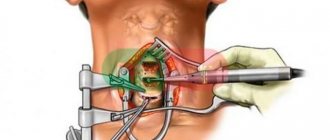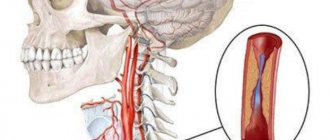Read in this article:
- Normal or pathological?
- What to do if the pressure on the right and left hands is different?
- Increase and decrease in pressure
- Reasons for the differences
- How to recognize blockage of blood vessels?
- How can the doctor help?
- How to avoid serious pathologies?
Everyone knows that blood pressure is measured on the arm. But if you put the blood pressure cuff on your left arm first and then on your right, the results may well be different.
Normal or pathological?
The difference in pressure levels on the right and left hands is a fairly common occurrence, but it is accompanied by many myths and misconceptions. Some of them may be dangerous. For example, in the literature there is information that approximately 20% of people whose tonometers show different numbers on different hands die within 10 years. It also notes that we are talking about a difference of 20 mm Hg. and more.
After such a “discovery,” most people check their own pressure on both hands. And if differences are discovered, the person panics and tries to take action. Most often they involve self-medication, which is not always safe for the body.
Meanwhile, the difference in pressure is a variant of the norm, and only 15-20% of such people need treatment, and only after a serious examination. With such a question, you need to go to a therapist, who will prescribe all the necessary tests, compare them with your medical history and identify the cause of the differences.
If necessary, the doctor issues a referral to a specialist: a cardiologist, a vascular surgeon, a neurologist. Accurate diagnosis and treatment prescribed based on it will help prevent complications and restore normal blood pressure.
What to do if your ankles are swollen?
Of course, if you notice that your legs are regularly swelling, you should consult a doctor.
Swelling in your feet and ankles may indicate overuse of your legs during the day, or it may be a sign of a serious medical condition such as varicose veins or lymphedema. What is the true cause of edema can only be determined by a specialist. And by following all his recommendations, you will be able to maintain the beauty and health of your feet for as long as possible.
And some traditional medicine recipes can help quickly relieve an unpleasant condition:
- take a contrast shower or bath. Sometimes such activation of blood circulation is enough to relieve swelling, especially if it is caused by tired legs.
- A compress with blue clay helps improve the condition of your feet. Dilute blue clay (it is sold at the pharmacy) with water to the consistency of sour cream and apply to the area of swelling. Let dry and leave for about an hour. You can wrap your leg in film so that the clay does not crumble when it dries.
- baths with sea salt, mint, birch and juniper leaves relieve tired legs and help reduce swelling.
If swelling is constantly observed, introduce into your diet foods that have a diuretic effect: watermelon, cucumbers, parsley, it is also recommended to drink pumpkin juice.
What to do if the pressure on the right and left hands is different?
If you get different data when measuring pressure on two arms, you need to analyze several factors:
- The magnitude of the differences is within 10 mmHg. is not a cause for concern. But the larger the gap, the higher the risk of pathology;
- Compliance with the norm - when the indicator on one hand corresponds to the norm or indicates increased blood pressure, and on the second it is higher - this is a less dangerous situation. The likelihood of a pathological process is greater when the pressure on one hand is normal and the pressure on the other is low;
- Right-handed-left-handed - increased pressure on the main working hand is considered normal;
- Age – the difference in pressure on the two arms is more often recorded in adolescence and old age;
- Physical activity level – differences may occur due to vigorous exercise or heavy work;
- Unusual symptoms and health complaints – their presence indicates the need for examination.
It is especially important to measure the pressure on both arms for people who do not monitor the indicator regularly and use a tonometer occasionally. But even with daily measurements, it is worth comparing the indicators from both hands once a month.
So, a simple rule: the difference in pressure on the two arms is within 10 mm Hg. – physiological norm. Approximately 50-60% of people will get exactly this result with the appropriate measurements. If the differences are more significant, you should consult a doctor.
Why does one leg swell?
You can often hear the complaint that only one leg is swollen at the ankle. There may be several reasons for this.
Injury . Sometimes a person can get injured in the ankle joint and not even pay attention to it (what we commonly call “twisted his ankle”). And only when the ankle in the area of the injured one begins to swell, do we remember that there really was an injury.
Joint damage, including arthrosis. If you have a serious ankle condition, such as osteoarthritis, circulation may be impaired, leading to swelling of the foot and ankle.
Insect bite or allergic reaction. Swelling of one ankle, especially in the warm season, can often be associated with an allergic reaction.
Infection . If you injure your leg and do not treat the wound, it may become infected and subsequently develop unilateral edema.
Thrombosis. This is a very dangerous condition, and if you notice any signs of it, we recommend that you consult a doctor immediately. Unilateral swelling may indicate blockage of the vessel by a thrombus. Self-treatment in this case is impossible; only specialists can cope with this condition. Also, with thrombosis, redness may be observed on the skin, which spreads along the course of the vessel.
Varicose veins In addition to the listed conditions, complaints about swelling of the right or left leg at the ankle may be associated with the development of varicose veins. Swelling is one of the first signs of this disease. In the early stages, this is not constant swelling that goes away after a night's sleep, rest or some exercise. At a later stage, they begin to spread from the ankle higher and become permanent.
Lymphedema. Another dangerous disease for the body, in which only one ankle may swell, is lymphedema, a violation of the outflow of lymph. When the disease first begins, lymphedema is mild. As lymphedema progresses, the swelling becomes firm and you can no longer apply pressure to the area of swelling with your finger. If you notice that the nature of the swelling is changing, be sure to consult a doctor - lymphatic swelling can only be removed with the participation of a specialist and with constant treatment.
Increase and decrease in pressure
The closest thing to pathology is a decrease in pressure on one arm with normal or slightly elevated levels on the other. Much depends on lifestyle and which hand is the working one. For example, in a right-handed person who ignores physical activity, the pressure on the right hand is usually lower than on the left. The same situation is typical for left-handers who engage in physical labor or sports. The difference may gradually increase, approaching 20 mmHg.
Why is this happening? The blood supply to the upper extremities is provided by two arteries. The left one comes from the aorta, the pressure in it is high. The right one comes from the brachiocephalic trunk, where the rate is lower.
Another situation: a right-handed person devotes a lot of time to sports training. At the same time, the muscles on the right strengthen, become denser, and their volume increases. In this case, the arteries are compressed and the pressure increases. But even in this case, the indicators are considered normal if the difference does not exceed 20 mm Hg.
Note! If the pressure readings on the two hands are different, the higher one is considered true.
Reasons for the differences
Only a doctor can determine the exact cause of the difference in pressure in the two arms. But there are some signs that you can analyze yourself:
- On one arm the pressure is normal, on the other it is increased - this may be due to vegetative-vascular dystonia or individual characteristics of the structure of the arteries;
- On one hand the pressure is increased, on the other - even higher - such manifestations are caused by constant stress, lack of sleep, hypertension, vegetative-vascular dystonia;
- On one arm the pressure is low, on the other – within the normal range or high – there is a possibility of obstruction of the arteries and problems with the blood supply to the arm.
Problems with arterial patency are caused by compression of large vessels, which narrows or blocks the lumen.
Arterial obstruction develops against the background of:
- Atherosclerosis - cholesterol deposits inside the vessels create plaques that block the lumen;
- Thrombosis, thromboembolism - blood clots are called blood clots that form inside the vessels and impede blood flow;
- Aneurysms - sac-like expansions appear on the blood vessels, preventing normal blood flow;
- Aorto-arteritis – inflammation of the vascular walls, causing thickening of the membranes;
- Scalenus syndrome – the subclavian artery is surrounded by muscles that can harden and compress the arteries.
The causes of obstruction of large vessels can be injuries, surgical operations, the appearance of malignant or benign neoplasms in the soft and bone tissues of the chest or shoulder.
How to recognize blockage of blood vessels?
Blockage of blood vessels, which does not allow blood to circulate normally, may well manifest itself in a decrease in pressure in one arm. In such situations:
- The brush loses strength;
- The fingers become pale and cold;
- Numbness appears;
- Blueness of the skin appears on the fingers or the entire hand.
When the pressure on the right hand decreases and at the same time dizziness and headaches, vomiting and nausea, difficulty speaking and distortion of the face, weakening of attention and memory, paralysis of the body on one side appear, this indicates problems with blood circulation in the brain. The fact is that nutrients to the brain and right arm come through arteries that start from the aorta in the form of one trunk.
How can the doctor help?
When the difference in pressure in two arms exceeds 15 units, you need to consult a doctor and undergo a diagnostic examination. Regular blood pressure measurements are required; consultation with a specialist may be required.
Treatment in such situations is selected individually and may consist of:
- Taking medications with a blood thinning effect - this helps restore vascular patency and improve blood circulation;
- Exercise therapy to activate blood circulation;
- Physiotherapeutic procedures.
Sometimes conservative methods do not bring results. Then a surgical operation is prescribed to remove atherosclerotic plaques, blood clots, install stents on the vessels, and replace damaged arteries with prostheses.
The main thing to remember is that a timely visit to the doctor is the main condition for identifying the problem and the key to eliminating it.
Why are pressure measurements taken in the leg area?
Blood pressure readings are taken on the legs for diagnostic purposes. If the doctor suspects that the patient has a narrowing of the vessels of the lower extremities, the patient undergoes such a study. Measuring blood pressure in the legs is considered a fairly effective method because it immediately reflects changes in the patient's blood flow. In addition, the ratio of blood pressure readings in the legs and arms is calculated - the ankle-brachial index. The index is used to assess the severity of arterial damage in the legs. In addition, by calculating the index value, the doctor can monitor the development of detected arterial disease.











